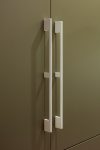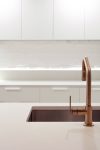
One of the first questions to ask when you're thinking of renovating your kitchen is obviously how much money you need to invest. The 15% rule allows you to establish a basic budget that will determine the scale of your project. Find out how to make the calculation!
By 15%, we mean 15% of the total value of your home. For example, a new kitchen in a 500,000$ house should be worth around 75,000$, including the purchase of new appliances.
Depending on the way you plan on using your kitchen, this percentage can be adjusted slightly up or down. For example, if it’s a new kitchen for your secondary residence that you plan on selling in the next year, you may want to keep costs down somewhat.
Why 15%?
We often think renovating a space will add value to the property. The investment must be significant enough for the property to gain value, and just high enough to get an interesting return on investment. For example, a $5,000 investment in a new kitchen for a house worth $300,000 might significantly lower the value of the house.
A 15% ratio lets you set a starting point from which you can have room to manoeuver, and the budget will be refined when you clearly evaluate your needs and choose materials.
It can seem like a big amount, however. Keep in mind that you can adapt your kitchen by making certain intelligent choices to reduce the bill. For example, you can choose a less costly backsplash or ceramic, and keep your current appliances.
The 3 key elements that influence the budget

1. The surface area of the kitchen
The size of a kitchen considerably influences cost. A very small kitchen can allow its user to dedicate a bigger budget to high-end materials, which in a very large kitchen might imply compromises. In general, the size of a kitchen is rather representative of the value and architecture of a property.
2. Choice of materials


Two kitchens of similar size can have a very similar look, but a completely different budget. It’s all in the choice of materials.
For example, kitchen cabinets alone come in a wide range of prices and qualities. Think of melamine, which is more affordable than solid wood, lacquer or advanced engineering products. The same goes for counters! Natural stone like marble or granite are more expensive than counters made of fiberboard.
Apart from cabinets and countertops, the choice of backsplash and floor covering also come into play when estimating your budget.
3. Taking needs into account


In the end, certain specific needs could impact the savings needed to carry out your project.
Do you want to keep or change your current appliances? Are you hesitating between a built-in oven or independent stovetop, or rather a stove? What refrigerator should you choose? Prices will vary from one model to another, and your choices will impact the final budget of your project.
Moreover, the storage space required and hardware used to help organize your kitchen will also need to be taken into account.
Calculate!
Value of my property x 15% = Estimated budget
You have a better idea of what your budget is going to be? Now it's time to clearly identify your needs?